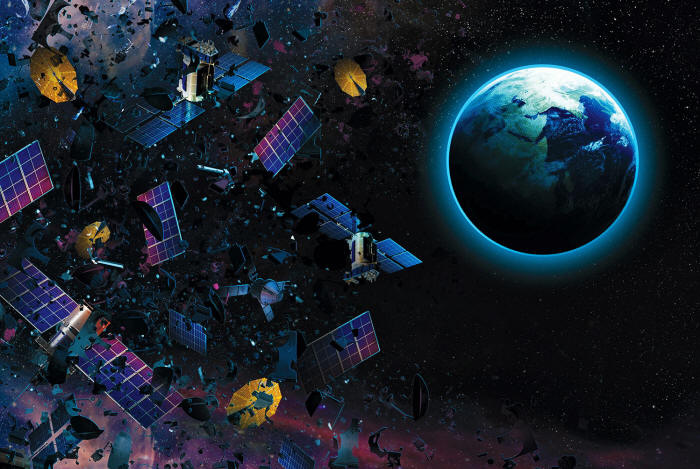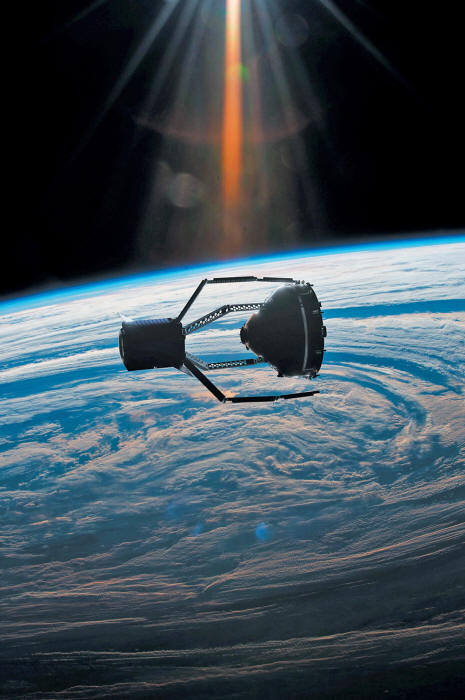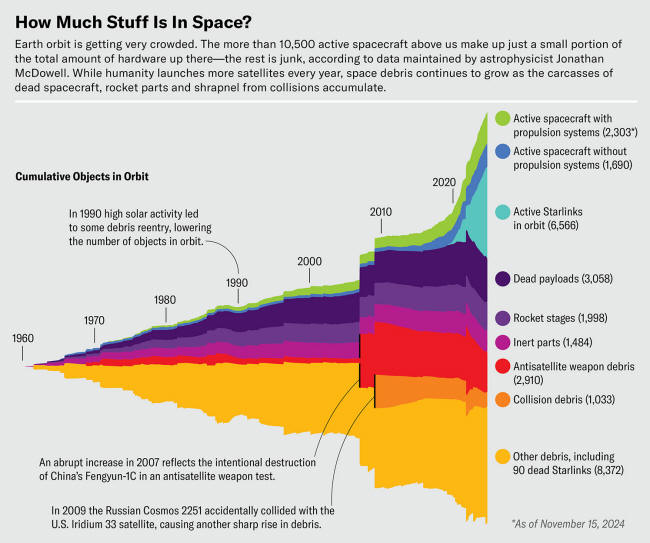|
will become a crisis if we don't act soon...
This rapid expansion of human activity in outer space has filled Earth orbit with space trash, from dead satellites to used-up rocket parts.
The region is already so crowded that working satellites run the risk of colliding with bits of garbage from previous generations of spacecraft. Even the International Space Station often has to adjust its orbit to dodge debris. Currently there are more than 25,000 pieces of trackable human-made junk larger than 10 centimeters orbiting Earth.
The more we put up there, the greater the chance that pieces of debris (traveling at relative speeds up to 15 times faster than a bullet) will strike working spacecraft, creating even more dangerous trash.
The catastrophic collision in 2009 between the defunct Russian satellite Cosmos 2251 and the operational Iridium satellite, for example,
Orbital space is a finite resource, and it's rapidly being consumed by a few organizations, notably,
SpaceX, for instance, owns and operates the majority of all working satellites, and the company aims to launch tens of thousands more satellites to provide global broadband Internet coverage.
Similarly, Amazon plans to deploy 3,236 satellites for its broadband network.
Giving everyone unfettered access without global coordination and planning means that eventually no one may be able to use it.
If we keep up this pace, orbital space will become unusable - especially the most popular region, low Earth orbit (LEO), which extends up to 2,000 kilometers in altitude.
When looking at all orbital regions, we may lose services we've come to rely on:
Today nearly every satellite that is launched is equivalent to a piece of single-use plastic, in that its fate is to become detritus.
We are heading toward a tragedy of the commons in orbital space: giving everyone unfettered access without global coordination and planning means that eventually no one may be able to use it.
As we continue to push the boundaries of space exploration and commercialization, there is a growing movement to rethink our approach to using the space environment - to move to a strategy anchored in stewardship and sound waste-management principles.
I believe we must leave behind our "linear space economy," where we use and abandon, and move toward a "circular space economy" - a sustainable way to use space that emphasizes the reuse, recycling, and efficient management of space resources.
Just as we are reckoning with how to conserve ecosystems on Earth for future living creatures, we must think of space as an environment worthy of preservation. In fact, reforming how we operate in space is critical for Earth conservation.
The production, launch and operation of satellites and rockets consume vast amounts of resources and energy, contributing to greenhouse gas emissions and environmental degradation.
Rocket launches release pollutants into the atmosphere, including carbon dioxide, soot and aluminum oxides, which cause atmospheric damage and contribute to climate change.
Moreover, the practice of uncontrolled reentries, where defunct satellites and rocket stages are allowed to burn up in the atmosphere, adds to atmospheric pollution and creates the risk of debris falling on people and property on Earth.
In 2024, for instance,
The ClearSpace-1 mission is due to launch in 2025 to rendezvous with a piece of a Vega rocket. This illustration shows ClearSpace-1 capturing the debris with robotic arms. The mission will aim to drag the rocket part down
to burn up in
Earth's atmosphere.
A circular space economy would represent a paradigm shift toward sustainable space practices, drawing inspiration from circular economy ideas that are gaining traction here on Earth.
"Circularity" in this sense refers to waste-management principles calling for the end of life of a product to be designed for the object's reuse or recycling.
We won't be able to enact a circular space economy without some technological innovations.
We don't currently have techniques to service all spacecraft in orbit, although several companies and space agencies are working on it.
We must create technology to extend satellites' operational lifespans and reduce the need for costly and resource-intensive replacement missions.
We need spacecraft that can approach aging satellites and dock with them, using robots to repair, refuel and upgrade them.
We'll also need a way to reuse and recycle satellites when their working lives are over.
Space exploration also raises fundamental ethical questions about fair resource extraction, ownership and environmental stewardship.
Currently all satellites become trash when their primary mission ends, and new satellites are built from entirely new materials.
Researchers are working on ways to harvest materials from dead spacecraft to integrate into new vehicles and to use techniques to build new satellites out of used parts.
A positive step in this direction is the reusable rocket technology SpaceX is developing.
Not only does this save money - recycling boosters reduces the cost of each Falcon 9 launch by up to 30 percent - it generates less trash.
But so far,
We need more...
There's also been movement toward servicing working satellites in orbit.
In addition to saving money, inorbit servicing reduces the frequency of new satellite launches, which in turn minimizes the accumulation of space debris and the greenhouse gas emissions that come with rocket launches.
Removing debris from orbit is another challenge.
Different types of trash require different removal techniques, with many ideas coming from the fishing industry: some strategies use nets, others harpoons, and still others hooks.
Each removal technology has limitations and works only for a subset of the objects that need to be fished out of orbital space. It's also really expensive to retrieve any kind of space trash because anything that is not being actively controlled in space is tumbling.
This means that to grab something to remove it, you must either find a way to steady the space detritus or make your debris-removal satellite tumble along with it.
Detumbling debris takes a lot of energy, which results in high propellant costs.
Jen Christiansen Source: "Satellite Statistics: Satellite and Debris Population," Jonathan's Space Report (data)
Nevertheless, some progress has been made.
In 2021 a Tokyo-based company, Astroscale, ran the End-of-Life Services by Astroscale demonstration (ELSA-d) mission, which launched two satellites:
The two craft successfully docked in orbit and then released, testing out a critical process for eventual debris removal.
ClearSpace-1 will use four robotic arms to grab onto the agency's PROBA-1 satellite and bring it safely out of orbit.
The project aims not only to clean up space but also to develop the ability to target larger and more complex pieces of debris. Finally, more efficient propulsion technology allows spacecraft to use less fuel and last longer on their initial load.
Electric propulsion systems, such as ion thrusters and Hall effect thrusters, are newer technologies that offer higher efficiency and fuel economy compared with traditional chemical propulsion.
These systems use electric power to ionize propellant and generate thrust, enabling spacecraft to achieve higher velocities and perform precise maneuvers over extended periods.
Electric propulsion is already used by many working satellites and will become increasingly common.
As we design new technology to conserve space, we'd do well to take inspiration from another kind of tech:
This kind of TEK emphasizes the importance of harmonious relationships between human activities and the environment.
It shows us that we have to see space as an extension of our natural world, where resources must be managed wisely and responsibly.
By respecting the wisdom of Indigenous communities, ESA not only advanced their scientific goals but also promoted a sustainable model that can be applied to future space missions.
New technology alone isn't enough to fix the space junk problem - we'll need legal reform, too.
The current global space policy is a patchwork of regulations that often lag behind technological advancements and the evolving needs of space activities.
The European Union is trying to pave the way by integrating sustainability principles into its space policies.
The E.U. has streamlined licensing processes for satellite launches and in-orbit operations across member states and has allocated significant funding for research and development on dealing with space debris.
The U.S., through its many government agencies, has begun working to streamline the licensing process as well. But most countries are dangerously far behind.
Governments have a strong hand to play in incentivizing companies to design and develop sustainable space systems.
One way to do this would be,
Ultimately the governments that permit spacecraft to be launched are liable for any damage their space objects may cause.
So the responsibility for cleaning orbital space falls to governments, but none of them, including Russia, the U.S. or China, are establishing robust markets for space garbage pickup and removal services.
Moreover, currently there is no legal mechanism to transfer this liability for damage from one launching state to another, making it complicated to put in place a space salvage law analogous to maritime policy.
The United Nations Committee on the Peaceful Uses of Outer Space also plays a pivotal role in developing international space law and norms.
Its Space Debris Mitigation Guidelines encourage member states to manage space debris and promote sustainable space operations. More than 100 countries have endorsed the guidelines, including the U.S.
Yet guidelines are not enforceable laws in and of themselves - they are merely suggestions.
Space exploration also raises fundamental ethical questions about fair resource extraction, ownership and environmental stewardship.
Organizations such as the International Institute of Space Law and the U.N. Office for Outer Space Affairs are trying to develop ethical guidelines for responsible ways to use space resources that emphasize transparency, international cooperation and sustainability.
Initiatives such as the Space Sustainability Rating, which aims to certify space missions based on sustainable practices, could encourage companies and nations to act responsibly.
Preserving the space environment for future generations is a moral imperative.
In the short term,
A circular space economy is the only way to keep space usable indefinitely.
In the long term, fostering international cooperation - and international treaties requiring sustainable space practices - is critical.
The Inter-Agency Space Debris Coordination Committee, an intergovernmental organization dedicated to combating the problem of orbital trash, is a promising step.
The ESA's Clean Space initiative is another smart approach to reducing space debris through technology development and policy changes.
The establishment of a circular space economy is not just an option but a necessity for the sustainable future of space exploration.
By adopting the principles of reuse, recycling, and efficient resource management, we can lower the risks of space debris collisions, preserve resources, and ensure that outer space remains a viable domain for scientific discovery and commercial innovation.
Policymakers, industry leaders, scientists and the global community must embrace a sustainable approach to our activities in Earth orbit, securing its potential for generations to come.
|




